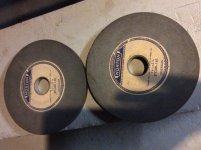Hi everybody,
An older friend of mine gave me a bunch of vintage nos and lightly used surface grinding wheels and smaller ones for a toolpost grinder. Anyway norton wheel threw me off as I could not find documentation on what it does. Ferrous?, non Ferrous? Carbide? Thanks curious. The wheel mounts on a typical 6 12
Danny
An older friend of mine gave me a bunch of vintage nos and lightly used surface grinding wheels and smaller ones for a toolpost grinder. Anyway norton wheel threw me off as I could not find documentation on what it does. Ferrous?, non Ferrous? Carbide? Thanks curious. The wheel mounts on a typical 6 12
Danny



 )
) .
.